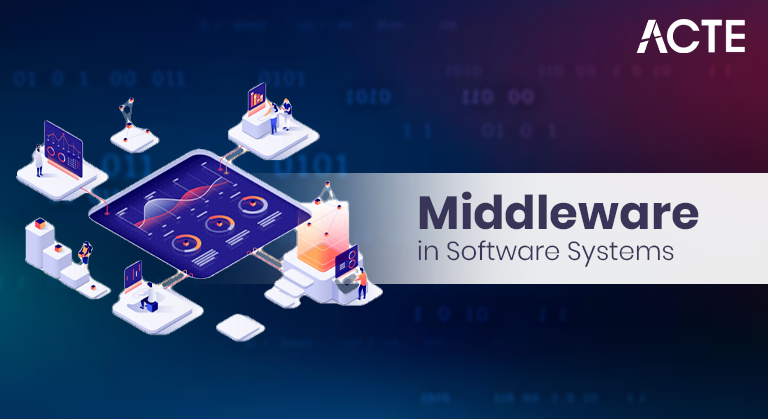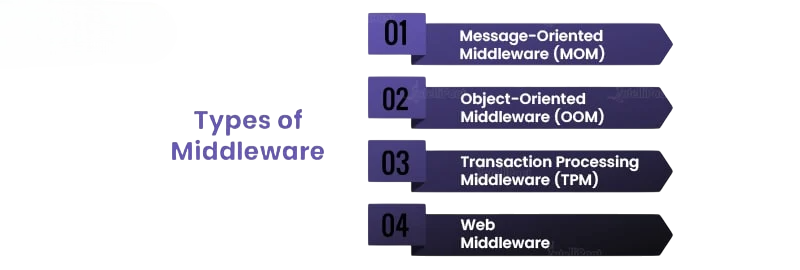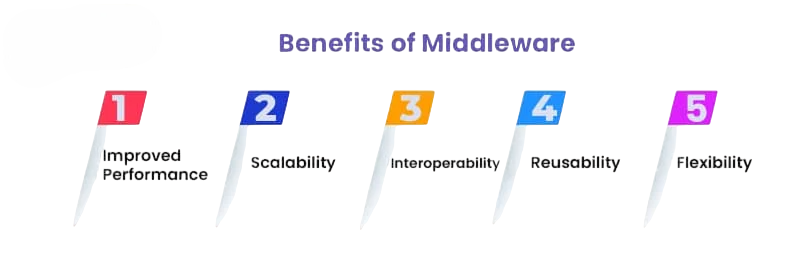
- Definition of Middleware
- Role in Application Architecture
- Types of Middleware
- Middleware in Web Applications
- Communication Middleware
- Database Middleware
- Messaging Middleware
- Middleware Examples (Express.js, Spring)
- Security in Middleware
- Future of Middleware
What is Middleware?
Middleware is a layer of software that sits between an application’s core logic and the underlying operating systems, databases, or networks it relies on. Its primary role is to facilitate communication, data management, security, and other services so that application developers can focus on business logic rather than low-level infrastructure concerns. In simple terms, middleware is the “glue” that connects different parts of an application or different applications altogether, ensuring smooth data exchange and coordinated functionality. To implement and customize such integrations effectively, exploring Python Training reveals how developers can use frameworks like Flask or Django to build middleware layers that handle routing, authentication, and data processing across complex systems. Middleware is not limited to one specific type of system; it can operate in distributed systems, enterprise applications, mobile platforms, and cloud environments. For example, when a web application retrieves data from a database, middleware can handle the request routing, authentication, data formatting, and error handling before the data reaches the end user.
Interested in Obtaining Your Python Certificate? View The Python Developer Course Offered By ACTE Right Now!
Definition of Middleware
Formally, middleware can be defined as software that provides common services and capabilities to applications beyond those offered by the operating system. It abstracts complex operations into reusable components, standardizes communication, and manages cross-cutting concerns such as logging, transaction handling, and message queuing. To optimize these processes efficiently, exploring Dynamic Programming reveals how breaking problems into overlapping subproblems and storing intermediate results can dramatically improve performance in systems that rely on repeated computations and modular logic. This definition highlights an important point: middleware is not the business logic itself, nor is it the physical hardware, it is the supportive layer in between. By handling repetitive and complex infrastructural tasks, middleware allows application developers to work at a higher level of abstraction, resulting in faster development and more maintainable systems.
Role in Application Architecture
In modern application architecture, middleware plays a central role by acting as the bridge between the presentation layer, application logic layer, and data layer. To ensure these layers interact reliably under unexpected conditions, exploring Exception Handling in C++ reveals how structured error management using try, catch, and throw statements helps maintain system stability, improve debugging, and safeguard critical operations across distributed environments.
Consider a typical three-tier architecture:
- Presentation layer: The user interface (e.g., a browser or mobile app).
- Business logic layer: The core application code that implements rules and processes.
- Data layer: The databases and storage systems.
Application Architecture operates across these layers, handling communication between them, enforcing security policies, managing transactions, and ensuring that components work together smoothly even if they are developed in different languages or run on different platforms. In service-oriented architecture (SOA) and microservices, middleware becomes even more important. It manages API calls, orchestrates services, and supports features like load balancing, service discovery, and fault tolerance. Without middleware, developers would have to manually handle these cross-service interactions in each component, leading to duplication and increased complexity.
Gain Your Master’s Certification in Python Developer by Enrolling in Our Python Master Program Training Course Now!
Types of Middleware
Types of Middleware come in several forms, each tailored for a specific purpose. The main types include: To optimize how these middleware layers access and manage data, exploring Searching in Data Structure reveals how linear search, binary search, and hash-based techniques enable efficient data retrieval across distributed systems and modular components.

- Web Middleware: Handles HTTP requests and responses in web applications (e.g., Express.js middleware, ASP.NET middleware).
- Communication Middleware: Manages data exchange between distributed components using protocols like TCP/IP, gRPC, or SOAP.
- Database Middleware: Simplifies database access and transactions, providing abstraction layers over database drivers.
- Messaging Middleware: Manages asynchronous communication via message queues and brokers (e.g., RabbitMQ, Kafka).
- Transaction Processing Monitors (TPMs): Ensure reliable execution of transactions across multiple systems.
- Remote Procedure Call (RPC) Middleware: Allows a program to execute code on a remote machine as if it were local.
- Object Middleware: Manages distributed objects in technologies like CORBA or Java RMI.
Often, enterprise applications use more than one type of middleware at the same time, depending on their architecture and integration needs.
Middleware in Web Applications
In web development, middleware is a function or set of functions that process HTTP requests before they reach the main application logic or before the response is sent back to the client. Middleware in this context is typically modular and stackable, multiple middleware components can be applied in sequence. In Express.js, middleware functions are essential for managing requests. They make your application more efficient and organized. For example, they can parse JSON request bodies, which allows you to easily process incoming data. Middleware also helps authenticate users, ensuring that only authorized people can access certain parts of your application. To handle and structure this data efficiently, exploring Python List vs Tuple reveals how choosing the right data type impacts mutability, performance, and memory usage especially when managing request payloads and session data in Python-based web applications. It logs requests, giving you valuable insights into how your application is used. Serving static files like images, stylesheets, or scripts is another job of middleware, which simplifies file management. Additionally, middleware effectively handles errors by catching them and providing appropriate responses. A common example is a function defined with app.use(), which applies these features seamlessly. Overall, middleware improves the Express.js framework and enhances both development and user experience.
- function logger(req, res, next) {
- console.log(`${req.method} ${req.url}`);
- next();
- }
- app.use(logger);
Here, the logger runs on every request, performing its task and then calling next() to pass control to the next middleware. This modularity makes it easy to compose complex request-handling pipelines without cluttering the main business logic.
Communication Middleware
Communication middleware provides standardized ways for distributed systems to talk to each other. In large organizations, applications often span multiple servers, data centers, and even countries. Communication middleware ensures that these systems can exchange data reliably and securely, regardless of differences in hardware, operating systems, or programming languages. To implement such systems effectively, exploring Python Training reveals how Python’s robust libraries and frameworks empower developers to build scalable middleware solutions that support seamless integration across diverse environments.
Examples include:
- gRPC: A high-performance RPC framework using Protocol Buffers.
- SOAP and REST APIs: For service interaction over HTTP.
- CORBA: For cross-platform, language-agnostic communication between objects.
Communication middleware often includes features such as message serialization, compression, encryption, error detection, and retry mechanisms, ensuring smooth data transfer in distributed architectures.
Are You Preparing for Python Jobs? Check Out ACTE’s Python Interview Questions and Answers to Boost Your Preparation!
Database Middleware
Database middleware acts as an intermediary between applications and databases, abstracting the details of the database’s query language, connection handling, and transaction management. It allows developers to work with a consistent API, even when switching between different database systems. To handle nested queries, hierarchical data, or repeated operations efficiently, exploring Recursion in Data Structures reveals how recursive logic simplifies complex tasks like tree traversal, graph exploration, and dynamic programming making your code cleaner, modular, and easier to maintain. For example, ODBC (Open Database Connectivity) and JDBC (Java Database Connectivity) provide standardized interfaces for connecting to various databases without needing to know each vendor’s specifics. In C# and .NET applications, Entity Framework is a popular ORM (Object-Relational Mapper) that acts as database middleware, allowing developers to write queries in LINQ instead of SQL.
Messaging Middleware
Messaging middleware enables asynchronous communication between applications or services by passing messages through a broker or queue system. Instead of requiring both sender and receiver to be online at the same time, messages are stored until the recipient is ready to process them. To understand how such systems fit into modern development workflows, exploring How to Become a Programmer reveals how mastering core concepts like messaging, APIs, and asynchronous logic prepares you for real-world challenges in software engineering.
Popular messaging middleware includes:
- RabbitMQ: A reliable message broker using the AMQP protocol.
- Apache Kafka: Designed for high-throughput event streaming.
- ActiveMQ: An open-source message broker that supports multiple protocols.
Messaging middleware is essential in event-driven architectures and microservices, where different services emit and consume events independently. This approach improves scalability, fault tolerance, and system decoupling.
Middleware Examples (Express.js, Spring)
Two popular examples of middleware usage are found in Express.js and Spring Framework.
- Express.js (JavaScript): In Express.js, middleware functions have access to the req, res, and next objects. They can modify requests, perform validation, check authentication, log activity, or handle errors. Middleware can be applied globally or to specific routes, giving developers fine-grained control over the request lifecycle.
- Spring Framework (Java): In Spring, middleware is often implemented as interceptors or filters. Filters can process requests and responses before they reach controllers, handling concerns like CORS (Cross-Origin Resource Sharing), logging, and security. Interceptors work similarly but are typically tied to the MVC request processing cycle, providing hooks before and after handler execution.
Both frameworks demonstrate the same principle middleware sits between the incoming request and the application’s main processing logic, enhancing modularity and separation of concerns.
Security in Middleware
Security is one of the most important roles middleware can play. Middleware can act as the first line of defense by: validating inputs, enforcing authentication, and managing access control across distributed systems. To streamline these operations at the code level, exploring Macros in C reveals how preprocessor directives can automate repetitive tasks, enforce security checks, and inject consistent logic across modules enhancing both performance and protection.

- Authenticating users before allowing access.
- Authorizing requests based on roles and permissions.
- Encrypting data in transit using SSL/TLS.
- Sanitizing inputs to prevent injection attacks.
- Enforcing rate limits to protect against denial-of-service attacks.
For example, in Express.js, authentication middleware like Passport.js can verify credentials before a request reaches protected routes. In enterprise systems, middleware might also integrate with Single Sign-On (SSO) systems, OAuth providers, or LDAP directories to centralize authentication and authorization.
Future of Middleware
As technology evolves, middleware is adapting to trends like cloud computing, microservices, and serverless architectures. Modern middleware is becoming more lightweight, container-friendly, and API-driven. Cloud providers now offer middleware as managed services, such as AWS API Gateway, Azure Service Bus, and Google Pub/Sub, reducing the operational burden on developers. To integrate these services effectively into modern applications, exploring Python Training reveals how developers can leverage Python’s cloud-friendly libraries and frameworks to build scalable, secure, and interoperable systems with minimal overhead. With the rise of edge computing, middleware may also shift closer to the user, handling security, caching, and routing at the network edge to reduce latency. Artificial intelligence and machine learning may further enhance middleware by enabling predictive load balancing, automated threat detection, and adaptive routing.





